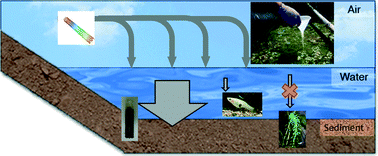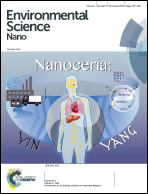Fate of single walled carbon nanotubes in wetland ecosystems†
Abstract
We report here the first studies addressing fate and transport of single walled carbon nanotubes (SWNTs) in aquatic mesocosms. The experimental design was structured to study the impact of nanomaterials within a tightly controlled and highly instrumented wetland ecosystems (aka mesocosm) and to address questions including fate and transport, effect on community structure, effects on biogeochemical function, and effects on productivity of the ecosystem. We added well-dispersed CoMoCat SWNTs (cSWNT,0 = 2.5 mg L−1) to the water column of a wetland mesocosm and examined the resulting phase distribution over time. Rapid settling of SWNTs from the water column was observed within a period of 2 days (Cw,t/Cw,0 < 0.01) after spiking. Samples from all mesocosm compartments (e.g. aquatic/semi aquatic plants, biofilm, mosquitofish and sediment) were analyzed to evaluate the transport and fate of SWNTs in the ecosystem. SWNTs were quantified in organism and sediment extracts using near-infrared fluorescence spectroscopy (NIRF). This technique can be used to quantitatively detect SWNTs in sediment and biotic matrices at environmentally relevant concentrations (MDLwater 5 μg L−1 MDLsediment 0.5 μg g−1 MDLbiota 5 μg g−1 wet weight) and qualitatively characterize SWNT samples before and after the studies. Results indicated that rapid aggregation and settling of SWNT resulted in accumulation of SWNT in surficial sediment. Sediment concentrations were spatially variable across the mesocosm, and thus estimates of SWNT mass balance within the mesocosm ranged from 7–48%. No bioaccumulation of SWNT in aquatic plants or vertebrates was observed over the 10 month incubation. However, NIRF imaging analysis suggested that mosquitofish ingested SWNT-laden particles but that burdens of SWNTs were confined to gut contents and may have been rapidly eliminated.


 Please wait while we load your content...
Please wait while we load your content...